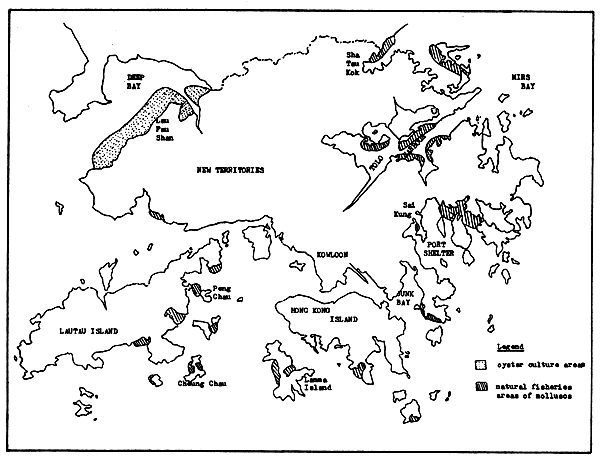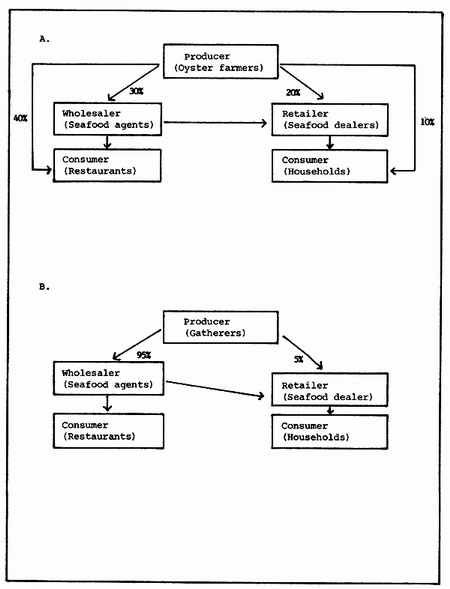Mok Tai Kwan
Agriculture and Fishery Department
I. INTRODUCTION
Among the many species of molluscs occurring naturally in Hong Kong, only a small number of bivalve mollusc species are currently produced mainly due to their limited availability and market demand. The major species of commercial importance include the Pacific oyster (Crassostrea gigas), short-neck or sand clam (Tapes philippinarum), fan mussel (Atrina pectinata), green mussel (Perna viridis) and the mud clam (Cyclina orientalis). Other minor species are the blood cockle (Anadara granosa), rock scallop (Chlamys nobilis), and pearl oyster (Pinctada marqaritifera). All these are produced from natural waters with the exception of the Pacific oyster which is at present the only species being cultured.
II. MOLLUSC SPECIES OF ECONOMIC IMPORTANCE
Oyster. Oyster culture is concentrated around Deep Bay which is situated in the North-Eastern corner of Hong Kong. It is run on a family basis by about 200 farm households or some 800 people. Oysters are cultivated on the intertidal mudflat areas of about 1,800 hectares by the traditional bottom laying method, using mostly concrete tiles and posts as cultch. In recent years, oyster growth has become very slow and it takes 5 years for juvenile specimens to reach the market size of 120 mm in shell length. This has led to the development of the a practice in which some farmers buy young oysters from China and fatten them in their beds for periods ranging between 3–12 months.
Mussels, clams and others. In the early 1980s, fan mussels were cultured in the coastal areas of Tolo Harbour and Sha Tau Kok because of its high market value and fast growth rate. Cultivation was practiced by the bottom method which involved transplanting mussel seed in sheltered areas with a silty bottom, an adequate supply of food and a gentle water current. Mussel seed of 5–10 cm in shell length would attain the market size of 15–20 cm in length in about 8–10 months. However, since 1987, this practice had been discontinued due to the decreasing market price and deterioration of the culture ground arising from land reclamation and water pollution. At present fan mussels are only gathered from natural grounds.
Clams, green mussels and other bivalve species are not cultured due to their low market value and limited demand. These have been traditionally collected from natural grounds. It is estimated that there are now about 450 hectares devoted to mollusc fisheries in the entire territory of Hong Kong. The natural grounds are mainly concentrated in the coastal areas of Sha Tau Kok district, Tolo Channel district, Sai Kung district and around the out-lying islands such as Lantau Island, Peng Chau, Cheung Chau and Lamma Island. Figure 1 shows a map of Hong Kong on which the natural mollusc fishery areas and oyster culture areas have been indicated.
III. PRODUCTION
The production and value of the major economic species of the locally produced molluscs for the period 1984–1988 are shown in Appendix 1. For the oyster, there is a steady decline in production which might be attributed partly to the deterioration of the aquatic environment and partly to the fact that the oyster beds have been rendered less suitable for growth as a result of repeated culture without any improvement of bottom conditions. For clams, mussels and the other species, there have been fluctuations in the annual production which might have been caused by the yearly varying weather conditions. Following a peak in production in 1986 a general trend towards lower production is seen in recent years as a result of rapid urbanization and industrialization along the coastal waters.
IV. MARKETING AND PRICES
Almost all of the oysters produced are marketed live or fresh and consumed in Hong Kong. Only negligible amounts are used for producing dried oysters and oyster sauce. The major oyster marketing village is Lau Fau Shan where the oysters are shucked before they are transported elsewhere. The shucked oysters are kept alive and fresh in containers filled with filtered seawater. Some of the oysters are retailed to consumers directly by the farmers on small stalls in the village itself, however most are sold either to restaurants or to seafood wholesalers. The latter distribute them to restaurants, hotels and seafood retailers. A flow chart showing the distribution channels in the marketing of oysters appears in Appendix 2(A).
Mussels, clams and other bivalves are normally sold fresh and consumed locally. Following harvesting, these molluscs, kept alive in tanks filled with seawater which is aerated, are landed at the nearest port. The landed catch is directly sold mostly to seafood wholesalers and some to retailers. The wholesalers use trucks to distribute the fresh product to restaurants and seafood retailers. A flow chart showing the distribution channels in the marketing of these molluscs appears in Appendix 2(B).

Figure 1. Map of Kong Kong showing the distribution of the natural mollusc fisheries grounds and the oyster culture areas.
The supply of locally produced molluscs is insufficient to meet local demand. Substantial quantities of fresh, chilled, frozen, salted and dried molluscs are imported. The net import of fresh, chilled and frozen bivalve molluscs has increased significantly from 1,887 MT in 1980 to 4,716 MT in 1988. The import of dried and salted products in 1980 was 1,820 MT, in 1988 it was 2,963 MT. The major supplying countries are China, followed by Japan, Australia, Thailand and Republic of Korea.
Prices of the locally produced molluscs are determined by free market demand and are not regulated by the government. There is a considerable fluctuation in the prices due to the import supplies, local supply and fluctuation in the seasonal availability of such organisms. Appendix 3 shows the average prices and marketing margins in the distribution channels for the locally produced oysters, sand clams and fan mussels in 1988.
V. SANITATION
Locally produced molluscs are usually cooked before being consumed. However, health hazards due to bacterial contamination remain when the molluscs are only half-cooked in order to retain the flavour and tenderness of the meat. This is particularly the case when the bivalves are harvested or cultured in sewage-polluted waters. At present no depuration practice is applied to remove pathogenic bacteria from the molluscs prior to sale. Consideration is being given by the government on the possibility of setting up depuration facilities to counteract the increase in sewage pollution and associated contamination by faecal bacteria.
VI. PROSPECTUS
It is recognized that the mollusc industry in Hong Kong has considerable development potential. Apart from increasing production by adopting more advanced culture techniques and by expanding the industry into new waters and culturing new economic species, there is the need to improve various aspect of marketing and processing including quality control, transportation and forms of product utilization. Introduction of depuration and other public health measures would contribute indirectly to the growth of the mollusc industry.
APPENDIX 1. Estimated production and values of major economic molluscs from natural fisheries and/or through culture in Hong Kong (1984–1988).
| SPECIES | 1984 | 1985 | 1986 | 1987 | 1988 | |||||
|---|---|---|---|---|---|---|---|---|---|---|
| Production (MT) | Value (HKS) | Production (MT) | Value (HKS) | Production (MT) | Value (HKS) | Production (MT) | Value (HKS) | Production (MT) | Value (HKS) | |
| Oyster (fresh meat)* (Crassostrea gigas) | 72 | 2,339,000 | 64 | 2,127,000 | 240 | 8,448,000 | 200 | 8,000,000 | 160 | 6,800,000 |
| Sand clam (shell-on) (Tapes philippinarum) | 490 | 1,830,000 | 540 | 2,100,000 | 600 | 2,350,000 | 560 | 2,240,000 | 560 | 2,688,000 |
| Fan mussel (shell-on) (Atrina pectinata) | 129 | 5,000,000 | 140 | 5,437,000 | 140 | 4,275,000 | 100 | 2,500,000 | 63 | 1,248,000 |
| Green mussel (shell-on) (Perna viridis) | 400 | 1,200,000 | 500 | 1,500,000 | 450 | 1,350,000 | 400 | 1,320,000 | 300 | 990,000 |
| Mud clam (shell-on) (Cyclina orientalis) | 120 | 444,000 | 135 | 500,000 | 150 | 570,000 | 140 | 532,000 | 125 | 575,000 |

APPENDIX 2. A. Marketing channels for locally produced oysters.
B. Marketing channels for locally produced clams, mussels and other bivalves.
APPENDIX 3. Average prices and marketing margins in the distribution channels of locally produced oysters, sand clams and fan mussels in 1988.
| SPECIES | Average price paid by wholesaler (HK$/kg) | Marketing margin (%)* | Average price paid by retailer (HK$/kg) | Marketing margin (%)* | Average price paid by consumer (or household) (HK$/kg) |
|---|---|---|---|---|---|
| Oyster (fresh meat) (Crassostrea gigas) | 42.5 | 12.5 | 49.4 | 10.5 | 55.2 |
| Sand clam (shell-on) (Tapes philippinarum) | 4.8 | 17 | 6 | 14 | 7 |
| Fan mussel (shell-on) (Atrina pectinata) | 19.8 | 14 | 23.7 | 14 | 27.6 |
* Marketing margins are in % of the price paid by consumers.